|
 Science writer Connie Barlow has produced a marvelous
Science writer Connie Barlow has produced a marvelous
book on an arcane subject within the field of evolutionary
theory. I think about it every two years when, in the autumn,
I rake up several wheelbarrows full of seed pods that litter the sidewalk under one of my Honey Locust trees. The fruits of this tree, like those of many other plants detailed in Ms. Barlow's book, are anachronisms of evolution. They coevolved with large herbivorous animals who served as the trees' agents of seed distribution. When, in North America, those herbivores became extinct 13,000+ years ago, the trees lost a critical part of their life cycle.
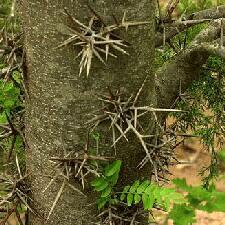
My Honey Locust has a second anachronism, long spikes of sharp needles that extend in clusters from the trunk of the tree to protect it from animals that graze on bark. There are no longer any animals in North America for these trees to be protected from, but they have not yet forgotten the past. I have in my yard a second Honey Locust that does not set fruit. It is a male tree, and a horticultural variety -- a thornless mutation. Since I live somewhat outside the current normal range of this species I do not know whether my thorny tree is a rare wild native or a genetic anomaly with respect to the horticultural variety most commonly seen. Before the last ice age the range of this tree extended further north, into southern Canada. After the retreat of the glaciers, which pushed it out of Canada, it could not make the return trip to former habitats because it did not have the help of those large herbivores to transport its seeds.
A number of animals do eat the seeds or the nutritious seed pods of the Honey Locust. But in North America only the reintroduced horse is capable of ingesting the seeds whole, scarifying them, and then planting them in dung in open areas where new trees can sprout. When my locust tree sets and drops fruit every other year I have no herbivores to help get rid of many bushels of it. In Africa today, Elephants are fond of similar fruits (see Kentucky Coffeetree below). The Mastodon may have been the last of the Honey Locust partnerships in North America.
|
|
Though biologists don't know what the long-extinct mastodons ate, they can make inferences by looking at the diet of elephants, the mastodon's closest living relative. The similarity of the coffee tree to certain foods that modern elephants love, coupled with the many ways elephants cope with plant poisons, makes a case for the coffee tree being part of the menu of their extinct mastodon relatives.
Roasting the beans destroys some of the toxins and people actually do make coffee using them. But the raw beans are toxic and the pods are very tough and leathery. There appears to be no current North American herbivore that disperses the seeds.
|

American Museum of Natural History
|
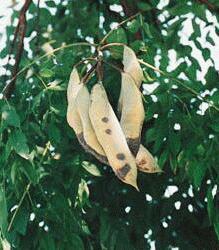

In no place in North America is the Kentucky Coffeetree abundant. A clue to its problem of seed dispersal is that, although it can grow well in upland areas, it is uncommonly found mainly in floodplains, where seeds have been carried down by flowing water. It appears that, without animal stomachs to digest the pods and pass on the seeds, a moist bottomland or floodplain is required to rot away the pods. The seed seem impervious to attack by insects or rodents.
Because of the toxicity the Coffeetree's pods are not fed to livestock, as is sometimes the case for the Honey Locust. This tree simply had to have had a capable herbivore associate to evolve the kind of fruit it still produces.
|
|
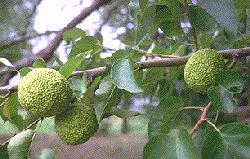
One can commonly see the large fruits of Osage Orange trees rotting on the ground where they fell. Nothing eats them. The pulp is a coarse and sticky latex-like substance. Cows that attempt to eat it risk choking on the rubbery mass. It seems probable that only a very large herbivore might have been capable of swallowing the fruit whole.
At the time Europeans appeared in western North America the range of the Osage Orange was severely restricted to the Red River region where Arkansas, Texas and Oklahoma join. Native Americans valued the wood for making bows (and it is still a choice for bowwood today). Because the wood resists rotting, the tree was planted where fencelines were wanted. Humans have cultivated the plant for practical and ornamental purposes. Yet, like the Kentucky Coffeetree, its natural spread tends to be downhill toward floodplains under the agency of flowing water. There are no natural herbivores to assist it.
|
|
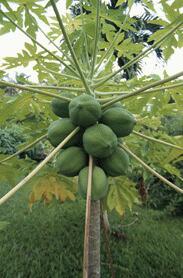

Avocado
and
Papaya
When considering plants or fruit with which we are familiar today we must remember that, especially in the case of foods we eat, we are dealing with modern horticultural cultivars. For example, the papayas that you see in supermarkets are almost surely larger than natural wild papaya fruits.
In her book, Connie Barlow provides a great deal of information comparing fruits such as the papaya and avocado with similar plants on other continents where there remain large herbivores capable of swallowing large fruits and of dispersing undigested seeds. The list of plants is long, and include the Ginkgo Tree, Cassia, Pawpaw, Breadfruit, and even curcurbits, the progenitors of our modern squashes and cucumbers.
And who are the ghosts, the missing fauna that once associated with all these plants? Ancient camels, flightless birds, dinosaurs, mastodons, ground sloths -- even the dodo has been suggested (and contested) as former seed dispersers. The list of missing fauna is undoubtedly as long as is the list of surviving anachronistic plants.
The Ghosts of Evolution is well written, packed with facts, nicely illustrated, and an enjoyable read. Moreover, it exposes you to a line of thinking rarely found in other books. Like vestigial organs, anachronistic plants and their fruits represent a kind of evidence best explained by coevolution and extinction. Or, as Theodosius Dobzhansky informed us, Nothing in Biology Makes Sense Except in the Light of Evolution.
|
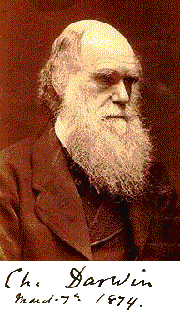

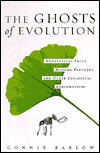 Ghosts of Evolution
Ghosts of Evolution

 Science writer Connie Barlow has produced a marvelous
Science writer Connie Barlow has produced a marvelous




